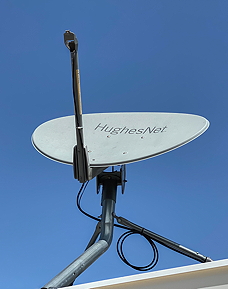Still Smokey Sky,
iPhone: Moon, Jupiter, Saturn, Summer Triangle
Posted: 20 September 2020
Friday, 18 September 2020, had smoke from the California wildfires making our sky gray with limited visibility. It was also very breezy. Saturday, 19 September, the sky looked better. On my 9 August 2020 report I mentioned that I had switched our home network from HughesNet to AT&T Wireless Internet, which uses the AT&T LTE cell network for Internet connectivity. We had used HughesNet satellite Internet service for nearly seven years but it had been unreliable for the past couple of years. The AT&T service is working well. We terminated our HughesNet service and on Saturday morning I removed the radio from the satellite dish to return it to HughesNet. The photo on the left shows the installation in October 2013 and the photo on the right shows that the radio at the end of the beam has been removed.


|
Open: Saturday, 19 September 2020, 1804 MST Temperature: 82°F |
Session: 1519 Conditions: Clear, smokey |
Equipment:
12" f/8 LX600 w/StarLock
2" 24mm UWA eyepiece
2" 30mm eyepiece
1.25" 15mm eyepiece
2" 4X Powermate
2" 2X Powermate
Atmospheric Dispersion Corrector
Camera:
iPhone 11 Pro Max
1810 MST: LX600 ON, StarLock OFF, High Precision OFF.
1812 MST: viewed the crescent Moon, 102X and 81X.
As the sun was setting, smoke from the California wildfires was very evident.


1825 MST: sunset.
I then relaxed on the observatory patio bench for awhile.
1846 MST: back at the 12" telescope I mounted the iPhone 11 Pro Max on the 30mm eyepiece using the Levenhuk adapter. Took this afocal 81X image using NightCap Camera (ISO 32, 1/90sec, 1X lens).

1850 MST: tried to observe the planet Mercury but it was too low in the western sky and lost in the smoke.
Viewed Jupiter, 81X. The four Galilean Moons were nicely lined up on the same side of the planet.
Viewed Jupiter, 650X, but seeing was not good enough for this much magnification. Viewed Jupiter, 325X, which was a better view. Added the Atmospheric Dispersion Corrector. Mounted the iPhone on the eyepiece and took these images of Jupiter (and two moons on the left) and Saturn using NightCap Camera (ISO 100, 1/25sec; ISO 400, 1/40sec; respectively, 1X lens)


1923 MST: viewed Saturn, 325X + ADC. Nice view at times. Then viewed Saturn, 102X. Three moons were visible.
I returned to the bench to just gaze up at the night sky. Sky conditions were a little better than they were two nights ago. There was less skyglow in the southern sky (although still much more than normal) so I could see the center of the Milky Way better. The Milky Way overhead was nice. And I could faintly see the Andromeda Galaxy (M31), although still not as well as usual.
I took this handheld photo of the Summer Triangle with the Milky Way just visible using the Camera app (Night Mode, 10 seconds, 1X lens).

1947 MST: last look at Saturn, 102X.
1948 MST: LX600 OFF.
Took a Sky Quality reading. It was slightly better than two nights ago.
|
Close: Saturday, 19 September 2020, 2005 MST Temperature: 77°F |
Session Length: 2h 01m Conditions: Clear, smokey, SQM 20.87 |
I have my posted my review of the Explore Scientific 2" 17mm and 12mm 92° eyepieces that has appeared in the latest issue of Astronomy Technology Today magazine.
Comments are welcome using Email. Twitter users can use the button below to tweet this report to their followers. Thanks.
Cassiopeia Observatory Home Page
Copyright ©2020 Michael L. Weasner / mweasner@me.com
URL = http://www.weasner.com/co/Reports/2020/09/20/index.html
